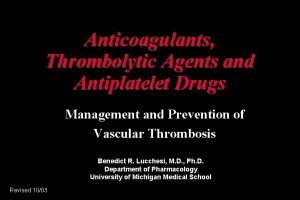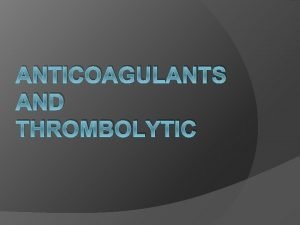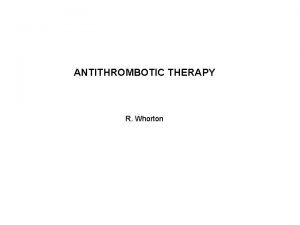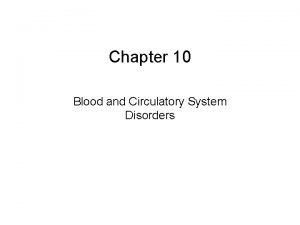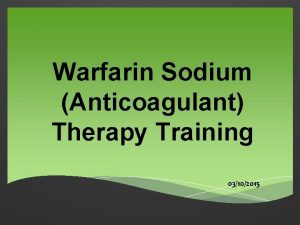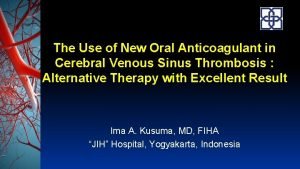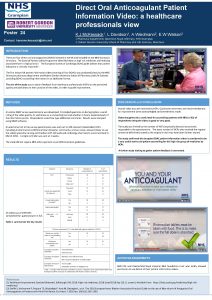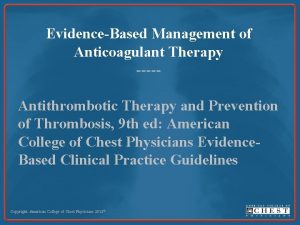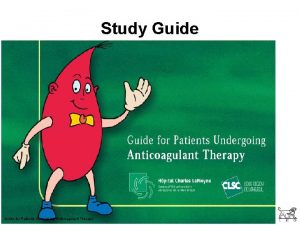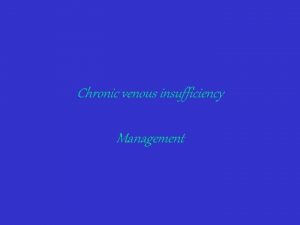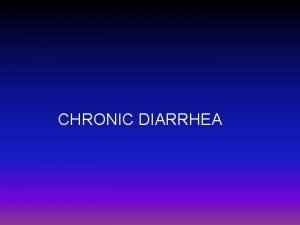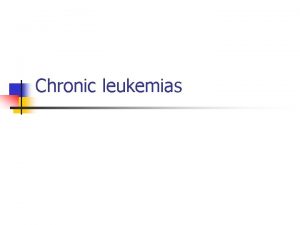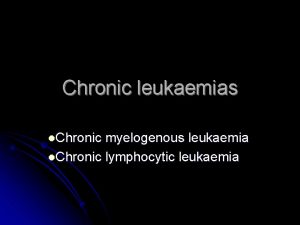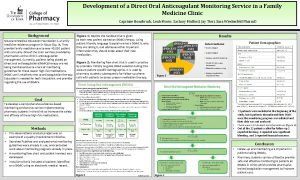Management of Patients on Chronic Oral Anticoagulant Therapy
















- Slides: 16

Management of Patients on Chronic Oral Anticoagulant Therapy R. Lee Jobe, MD FACC FSCAI North Carolina Heart and Vascular UNC Rex Healthcare Raleigh, NC

R. Lee Jobe, MD FACC FSCAI Financial Disclosures: Medical Advisory Board Boston Scientific Medical Ingenuities

Oral Anticoagulant Therapy: Scope of the Issue • Patients with CAD often have comorbid conditions requiring OAC – Atrial Fibrillation – Valvular Heart Disease – Arterial or Venous Thromboembolic Disease – LV or LA thrombus • 5 -8. 5% of patients referred for Cardiac Cath • Femoral Vascular Closure devices do not reduce the risk overall bleeding complications

What do the Guidelines Say? 2011 ACC/AHA USA/NSTEMI Wait til INR < 1. 5 No preference for access specified 2014 Guidelines silent on OAC 2010 ESC Guidelines Do not interrupt OAC Preference for Radial access

Strategies for Management of Oral Anticoagulant Therapy • For low risk patients, stop OAC 4 days prior to procedure, await INR < 1. 5 • For moderate/high risk patients, stop OAC and bridge with UFH or LMWH when INR < 2, perform cath when INR < 1. 5, then resume OAC with bridge • Perform catheterization from radial approach with uninterrupted OAC

OAC Delays Guideline Indicated Therapies for NSTEMI ACTION-GWTG 2007 -2009 Variable No Home Warfarin (n=62 061) Home Warfarin (n=5787) Among Patients on Home Warfarin Therapy INR <2. 0 (n=2680) INR = 2. 0– 3. 0 INR >3. 0 (n = 2006) 1101) P* Dia 89. 8 gnostic cath 81. 5 84. 6 81. 0 73. 2 <0. 0001 Cat 74. 4 h within 48 h 48. 4 61. 0 40. 2 27. 1 <0. 0001 PCI 54. 0 43. 0 42. 9 45. 3 38. 4 0. 02 PCI within 48 45. 6 h 26. 4 31. 5 24. 1 15. 4 <0. 0001 Arri 21. 0 val to cath, h§ 43. 3 28. 8 51. 1 66. 4 <0. 0001 Subherwal et al. Circulation. 2012; 125: 1414 -1423

Advantages of performing TRI on uninterrupted OAC has been long known

Comparison of Radial vs Femoral Cath/PCI on warfarin Transfusion 15% vs 0%, p=0. 004 Any Vascular or Bleeding Comp 23% vs 1%, p=0. 001 Baker et al. Am Heart J 2014; 168 (4): 537 -544

Advantages of Uninterrupted OAC • Avoid lengthy hospitalization for bridging • Avoid risk of thromboembolism off OAC • Reduce risk of vascular complication by avoiding femoral artery access • Reduced costs by reducing LOS and complication management

Special Considerations: If the INR is therapeutic (or NOAC is on board), do we still need to use routine anticoagulation for catheterization or PCI?

Radial cardiac catheterization • Purpose of heparin is to prevent radial artery occlusion • Appropriate dose varies- 40 -50 u/kg • Does warfarin provide the same protection?

Frequency of Radial Artery Occlusion after Transradial Access in Patients Receiving Warfarin n=86 n=250 Even if INR is therapeutic, procedural heparin is required to prevent RAO Pancholy et al, Am J Cardiol. 2014; 113(2): 211 -214

Strategies to Reduce Radial Artery Occlusion • Use lowest profile sheath or sheathless guide possible • Careful adherence to patent hemostasis technique • Administer anticoagulation with heparin even if INR is therapeutic

(Sort of a moot point, but…) In Patients on OAC, Is Heparin Required for Transradial PCI? • When TR stenting was first reported, patients on OAC routinely received 10 K IU heparin, and sheath pulled immediately post regardless of ACT • Other non-TRI trials have shown that warfarin and ASA is inadequate to prevent stent thrombosis

Incidence of adverse cardiac events (top) and stent vessel occlusion (bottom) in the three risk groups, differentiating the two antithrombotic regimens: anticoagulant and antiplatelet therapy. ISAR 1997 Coumarin+ASA Vs Ticlopidine+ASA Helmut Schühlen et al. Circulation. 1997; 95: 2015 -2021 Copyright © American Heart Association, Inc. All rights reserved.

Conclusions Continuing OAC with warfarin when using radial approach for cath and PCI • Safe • Lower risk of bleeding and vascular complictions • Reduced risk of thromboembolic complications from interrupting OAC • Reduced LOS • Reduced costs from complication management and LOS
 Kathryn connors md
Kathryn connors md Thrombolytic vs anticoagulant
Thrombolytic vs anticoagulant Anticoagulant examples
Anticoagulant examples Streptokinase mechanism of action
Streptokinase mechanism of action An anticoagulant is a substance that prevents
An anticoagulant is a substance that prevents Anticoagulant drugs
Anticoagulant drugs Warfarin strengths and colors
Warfarin strengths and colors Anticoagulant
Anticoagulant Anticoagulant
Anticoagulant Perimylolysis
Perimylolysis Rocking chair therapy for dementia patients
Rocking chair therapy for dementia patients Oral placement therapy for speech clarity and feeding
Oral placement therapy for speech clarity and feeding Psychodynamic and humanistic therapies have in common
Psychodynamic and humanistic therapies have in common Bioness bits cost
Bioness bits cost Psychoanalytic therapy is to as humanistic therapy is to
Psychoanalytic therapy is to as humanistic therapy is to The flinders model
The flinders model Kate lorig chronic disease self-management
Kate lorig chronic disease self-management

